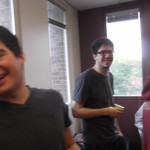Title: A Sound Way to Measure Nanostructures: Ultrafast Optics and Picosecond Ultrasonics
Speaker: Brian Daly, Vassar College
Abstract: We can take it for granted that progress in nanoscale science and technology in the coming decades will depend heavily on imaging and sensing methods with nanometer resolution. A number of established techniques can provide us with this resolution (e.g. electron microscopy, atomic force microscopy) but these are restricted to objects on or very near the surface of a sample. A wide range of nanostructures are currently under development across the spectrum of the sciences, and in many cases these structures come in the form of multi-layered stacks. As such, a method for the study of buried nanostructures and films is required.
One solution to this problem is to use ultrasound, which has been successful in medical and industrial fields for imaging with optimum resolution in the range of 10’s to 100’s of micrometers. In order to obtain nanometer scale resolution, we must use waves that have a much shorter wavelength (higher frequency) than traditional ultrasound. To do this, we use one of the most versatile tools of the quantum mechanical age, the ultrafast laser. An ultrafast laser produces pulses of light that are shorter than 1 picosecond, and when these pulses are absorbed by a solid layer, they generate extremely high frequency sound waves: what we like to call “Picosecond Ultrasonics.”
In this presentation I will give an overview of the way in which we use light to generate and detect high-frequency ultrasound in solid samples. I will also describe a companion technique for measuring thermal properties of nanoscale films known as Time-Domain Thermoreflectance
As always, lunch will be provided at 12:20 in Room N304, and all are welcome. The full schedule for the Fall term Physics and Astronomy Colloquium Series is here.













































